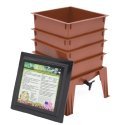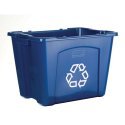 Vermicomposting has become trendy as of late, with such styles as Can-O-Worms, but what really makes people so comfortable with it is the fact that it is as easy as cleaning up kitty litter and at the same time, so environmentally sound.
Vermicomposting has become trendy as of late, with such styles as Can-O-Worms, but what really makes people so comfortable with it is the fact that it is as easy as cleaning up kitty litter and at the same time, so environmentally sound.
Worm bins get easier and easier to maintain as people come out with new ways to improve comfort and environmental friendliness through recycled materials with more efficient shapes and sizes that do the job with a more ecological tone.
But mostly, it is when people start to really understand what makes vermicomposting so desirable in-the-kitchen that gets them to start up their own worm-bin under the sink.
Those who choose to keep their vermicomposting systems indoors must remember that an excess of fatty, acidic or animal based foods like dairy products, eggs and meats may create a foul odor while worms linger over how much they really need to eat that stuff.
Oh sure, they will eat almost anything, not just kitchen scraps, and they will break it down into some of the cleanest and finest worm castings in the world (their insides are so rugged and well adapted to dealing with bacteria, that they can even destroy dangerous pathogens if need be), but they prefer regular kitchen refuse of plant origin.
In nature for example, worms like anything that just kind of plops down under a tree or is trampled under foot on a field, and as horses and other plant-eaters like cows and deer do leave droppings, they are completely different from the kinds of droppings animal-eating predators like cats and dogs leave.
This doesnt mean worms are strictly veggie loving, they will eat decomposing animal remains and can even adapt to do just that kind of job, especially if survival is on the line, but they just dont eat stuff like that as often in nature as they do veggie remains, so they have personal preferences for non-animal kitchen scraps.
Veggie lovers who strictly avoid animal based foods are usually the first to bring vermicomposting indoors, since their piles rarely (if ever) emit foul odors.
For those looking for an easy to use vermicomposting system, Can-O-Worms for example is one of these kinds of products that blends the latest in modern technology with the latest in eco-friendliness.
Made from 100% recycled plastic, this is the kind of product that could withstand hundreds of years out in the open weather if well kept, ultimately paying off its own ecological footprints as well as cutting down on household CO2 emissions.
This style vermicomposting worm-bin that stacks usually measures the same size as a kitchen trash can, with four different stacking drawers or in this case cans.
Once the first compartment is full, the next is just placed on-top with wet bedding (usually shredded newspaper) and a healthy days worth of kitchen scraps, the worms will migrate to the next bin looking for more food, thereby emptying the lower bin.
They are attracted to the smell of organic materials and can eat their weight in food scraps each day, so they travel up in search of the new food source; red-wigglers are the most aggressive and the most common in vermicomposters today.
With vermicomposters of the stacking style, one of the bins will usually take about a whole seven-day week to fill up with a family of five, so after about three or four weeks, three bins can be emptied into the garden and the top bin goes to the bottom of the stack.
It really is that simple, and the worms will just keep on working, day after day, but please remember to feed them! They are members of the family too, like cats and dogs, and they need to eat every day, especially red wigglers.
Vermicomposting with stacking worm-bins like Can-O-Worms is not only an ecologically correct thing to do, it is a fun thing to do, as the whole family (and even those who visit) will be able to learn about these noblest of noble earth dwellers, transforming waste into black-gold of the garden.





